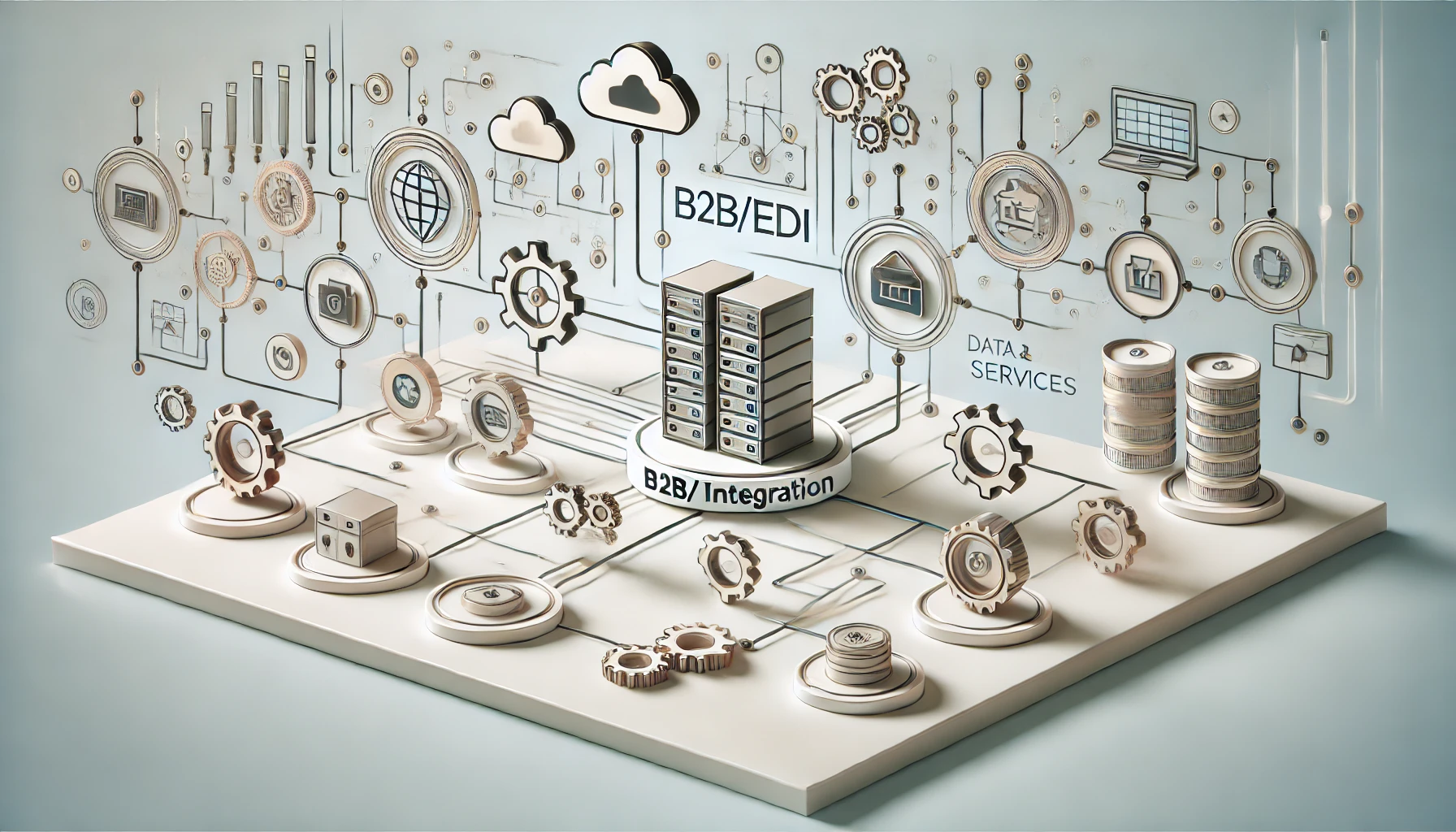As you embark on the exploration of B2B/EDI integration services, have you ever pondered the intricate web of costs that come with such a venture? The initial investment might just be the tip of the iceberg. Understanding the full spectrum of expenses involved in this process is vital for making informed decisions and ensuring the sustainability of your integration journey. So, let’s unravel the complexities together and shed light on what truly dictates the cost of these services.
Pricing Models
When considering the cost of B2B/EDI Integration Services, understanding the various pricing models is essential for making informed decisions. Service providers typically offer different integration options, each with its own pricing structure. Some providers may charge a one-time fee for the setup of the integration, while others opt for a subscription-based model where you pay a monthly or annual fee for ongoing support and maintenance.
Integration options also play a significant role in determining the cost. For instance, a fully managed integration service where the provider handles everything from implementation to maintenance will likely come at a higher cost compared to a self-service option where you have more involvement in the process. Additionally, the complexity of the integration, the level of customization required, and the volume of transactions can all impact pricing.
Cost Factors
When analyzing the cost factors of B2B/EDI integration services, it is crucial to compare different pricing models to determine the most cost-effective option for your business. Understanding the breakdown of implementation costs and gaining an overview of maintenance expenses will provide valuable insights into the overall financial implications of integrating these services. By examining these key points, you can make informed decisions that align with your budget and strategic objectives.
Pricing Models Comparison
Considering the various pricing models available for B2B/EDI integration services, it is crucial to analyze the cost factors associated with each option before making a decision. When it comes to service selection, different vendors offer pricing structures such as transaction-based fees, subscription models, and one-time setup costs. Transaction-based fees are charged per document exchanged, while subscription models involve a fixed monthly or annual fee regardless of the volume of transactions. One-time setup costs are upfront fees for implementing the integration solution.
Vendor comparison is essential in understanding the pricing models. Some vendors may offer a tiered pricing structure based on the number of trading partners or the complexity of integration required. Additionally, factors like support services, maintenance, and customization can affect the overall cost. It is important to evaluate the total cost of ownership over time, including any potential hidden fees or additional charges that may arise. By carefully examining these cost factors, you can make an informed decision when selecting a B2B/EDI integration service provider.
Implementation Costs Breakdown
For a comprehensive understanding of the cost breakdown associated with B2B/EDI integration services implementation, it is crucial to delve into the specific factors that contribute to the overall expenses. When considering the implementation costs breakdown, it’s essential to conduct a thorough ROI analysis and investment considerations to ensure the efficiency and effectiveness of the integration process. Here are three key factors to consider:
- Software Licensing Fees: Initial costs for procuring the necessary software licenses for B2B/EDI integration can vary based on the complexity of the system and the number of users.
- Customization and Configuration: Tailoring the integration to meet the specific needs of your business may involve additional costs for customization and configuration services provided by the vendor or third-party developers.
- Training and Support: Investing in training programs for employees to use the new B2B/EDI system effectively and ongoing support services post-implementation are crucial aspects that contribute to the overall implementation costs.
Maintenance Expenses Overview
Maintenance expenses play a critical role in the overall cost structure of B2B/EDI integration services. These expenses encompass various aspects such as software updates and system upgrades, which are essential for ensuring the efficiency and security of the integrated systems. Software updates are crucial for incorporating new features, fixing bugs, and enhancing performance. Regular updates help in maintaining compatibility with evolving technologies and industry standards. Failure to keep software up to date can lead to vulnerabilities and inefficiencies in the integration process.
System upgrades are another significant component of maintenance expenses. As technology advances, businesses need to upgrade their systems to keep pace with the changing landscape. Upgrades may involve hardware enhancements, software migrations, or infrastructure improvements to support the growing demands of B2B/EDI integration. By investing in timely upgrades, companies can avoid system failures, data breaches, and operational disruptions that could result in substantial financial losses. Overall, prioritizing maintenance expenses is crucial for ensuring the long-term success and effectiveness of B2B/EDI integration services.
Fee Structure
With regards to the fee structure for B2B/EDI integration services, a transparent breakdown is essential for businesses to assess the cost implications accurately. When considering service packages, businesses encounter different fee structures that can impact their budget. Here’s a breakdown to help you navigate this aspect:
- Fixed Pricing: Some providers offer fixed-price service packages that include a set list of services for a predetermined fee. This can provide cost predictability but may lack flexibility.
- Usage-Based Fees: In this model, fees are determined by the volume of transactions or data processed. While this can be cost-effective for businesses with fluctuating needs, it may lead to variable monthly expenses.
- Fee Negotiation: Providers may be open to fee negotiation based on factors like contract length, service level agreements, or bundled services. Engaging in negotiations can help tailor the fee structure to better suit your business requirements.
Understanding these fee structures and engaging in effective fee negotiation can help businesses make informed decisions when selecting B2B/EDI integration services.
Price Range Analysis
As you delve into the realm of B2B/EDI integration services, conducting a thorough price range analysis becomes imperative for informed decision-making. When considering service providers for B2B/EDI integration, the price range can vary significantly based on the complexity of the services offered and the reputation of the provider. Budget planning is crucial in this phase to ensure that you are getting the best value for your investment.
Service providers in the B2B/EDI integration space typically offer a range of pricing models, including subscription-based plans, transaction-based fees, or project-based pricing. Understanding these different pricing structures is essential in determining which provider aligns best with your budget and requirements. Moreover, some providers may offer additional services or support at an extra cost, so it’s important to factor in these potential add-ons when budget planning.
Investment Considerations
When considering the investment in B2B/EDI integration services, it is crucial to analyze the various cost factors involved. Understanding the Return on Investment (ROI) is essential to determine the long-term financial benefits of such integration. By carefully assessing both the costs and potential returns, you can make informed decisions that align with your business goals.
Cost Factors
A crucial aspect to consider when evaluating the cost of B2B/EDI integration services is the array of cost factors that come into play. To ensure cost efficiency and effective budget planning, it is essential to take into account the following key factors:
- Software Licensing: The cost of software licenses for B2B/EDI integration platforms can vary significantly based on the vendor, features required, and the number of users. Consider whether a one-time purchase or a subscription model aligns better with your budget planning.
- Implementation and Customization: Integrating B2B/EDI solutions often involves implementation costs, including setup, configuration, and customization to match specific business requirements. These costs can impact the overall budget, so detailed planning is essential.
- Maintenance and Support: Ongoing maintenance, updates, and technical support are crucial for the smooth operation of B2B/EDI integration. Factoring in the cost of support services ensures that your budget planning includes provisions for continuous system upkeep.
Consider these cost factors carefully to make informed decisions regarding B2B/EDI integration services.
ROI Analysis
Regularly, evaluating the Return on Investment (ROI) for B2B/EDI integration services is a critical step in the decision-making process for businesses. Conducting a thorough cost benefit analysis can provide valuable insights into the financial impact of implementing such services. By calculating the expected benefits against the costs involved, businesses can determine the potential ROI of B2B/EDI integration.
When analyzing the ROI of B2B/EDI integration services, it is essential to consider both tangible and intangible benefits. Tangible benefits may include cost savings from process efficiencies, reduced errors, and improved productivity. On the other hand, intangible benefits such as enhanced customer satisfaction and increased competitiveness should also be factored into the ROI analysis.
In addition to evaluating the direct financial gains, businesses should assess the strategic advantages that B2B/EDI integration can offer in the long term. These may include improved supply chain visibility, better decision-making capabilities, and enhanced partner relationships. By conducting a comprehensive ROI analysis, businesses can make informed decisions regarding the implementation of B2B/EDI integration services.
Value for Money Assessment
To assess the value for money of B2B/EDI integration services, it is crucial to conduct a thorough analysis of the costs incurred versus the benefits gained. When evaluating the value proposition of these services, consider the following key points:
- ROI Assessment: Calculate the return on investment by comparing the financial gains against the total costs involved in implementing B2B/EDI integration. This analysis provides a quantitative measure of the profitability of the integration services.
- Cost Benefit Analysis: Identify and quantify the costs associated with implementing and maintaining B2B/EDI integration alongside the benefits received. This detailed analysis helps in understanding the overall value derived from these services.
- Scalability and Flexibility: Evaluate how well the B2B/EDI integration services can adapt to the changing needs of your business. Consider whether the scalability and flexibility offered align with your long-term objectives and growth strategies.
Frequently Asked Questions
Are There Any Hidden Fees Associated With B2b/Edi Integration Services?
When considering b2b/edi integration services, ensure pricing transparency by asking detailed questions upfront. Hidden fees may exist, leading to unexpected charges. Stay vigilant, review contracts thoroughly, and inquire about additional costs to avoid surprises later on.
Can I Customize the Services to Fit My Specific Business Needs?
Sure! You have the freedom to tailor the services to your business needs. Enjoy the customization options and benefit from tailored solutions that align perfectly with your specific requirements, ensuring a seamless integration process.
How Long Does It Typically Take to See a Return on Investment?
Typically, you can expect to see a return on investment within 6-12 months with our customizable B2B/EDI integration services. Implementation timelines vary but can average around 3-6 months, with optional training options available for your team.
What Level of Customer Support Is Included in the Service?
When considering B2B/EDI integration services, it’s crucial to assess the level of customer support offered. Comprehensive technical assistance and prompt responses are key factors that directly impact customer satisfaction and successful implementation of the service.
Are There Any Additional Costs for Software Updates or Maintenance?
When considering software updates and maintenance costs, ensure software compatibility is maintained. Confirm ongoing support is included to address any issues promptly. Additional costs for updates or maintenance may vary based on service provider.



